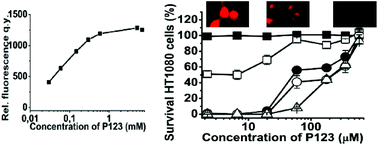The influence of Pluronics® on dark cytotoxicity, photocytotoxicity, localization and uptake of curcumin in cancer cells: studies of curcumin and curcuminoids XLIX†
Abstract
In order to apply

* Corresponding authors
a
School of Pharmacy, Department of Pharmaceutics, University of Oslo, P.O. Box 1068, Blindern, 0316 Oslo, Norway
E-mail:
ravinder.singh@farmasi.uio.no
Fax: +47 22856589
b Department of Radiation Biology, Institute for Cancer Research, Norwegian Radium Hospital, Oslo University Hospital, Oslo, Norway
In order to apply

 Please wait while we load your content...
Something went wrong. Try again?
Please wait while we load your content...
Something went wrong. Try again?
R. Singh, H. H. Tønnesen, S. Kristensen and K. Berg, Photochem. Photobiol. Sci., 2013, 12, 559 DOI: 10.1039/C2PP25249J
To request permission to reproduce material from this article, please go to the Copyright Clearance Center request page.
If you are an author contributing to an RSC publication, you do not need to request permission provided correct acknowledgement is given.
If you are the author of this article, you do not need to request permission to reproduce figures and diagrams provided correct acknowledgement is given. If you want to reproduce the whole article in a third-party publication (excluding your thesis/dissertation for which permission is not required) please go to the Copyright Clearance Center request page.
Read more about how to correctly acknowledge RSC content.
 Fetching data from CrossRef.
Fetching data from CrossRef.
This may take some time to load.
Loading related content
